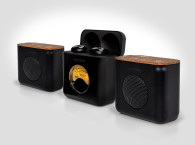
It's a well-established fact that Samsung will emulate and amplify anything it sees from Apple. From the same fonts to product naming, this has been a consistent behavior. But the June 10 Paris event even generated headlines from Chinese media and in online communities about how blatantly Samsung was following Apple's products lead, a more established tradition to be expected from all the OneOther or MeToo Chinese brands.
During the Galaxy Unpacked event, Samsung unveiled its Galaxy Buds 3 and Galaxy Buds 3 Pro true wireless earbuds with a design that is shockingly close to Apple's current AirPods and AirPods Pro design. For some reason, Samsung decided to leave behind the original rounded shape of the previous Galaxy Buds series, which was recognized at least for being original. Samsung Buds have never been outstanding examples in this competitive space, but at least they were selling well as accessories for Galaxy phones and are still popular among users of Android devices.
This design departure is even more disappointing given that the number of "AirPod" clones flooding the market will now make it even harder for Samsung to differentiate its own products, and given that the engineering teams at Samsung seem to be doing a genuine effort to offer new features and capabilities. Matching the "Galaxy AI" theme that dominated the Samsung event, the new Galaxy Buds Series 3 offer enhanced sound and communication quality, and innovative AI capabilities when combined with the brand's own smartphones.

One "improved quality" argument results from the fact that both the Galaxy Buds 3 and Galaxy Buds 3 Pro earbuds support the proprietary Samsung Seamless Codec (SSC) now adding an SSC UHQ mode. These build upon the standard SBC and AAC codecs to improve interference robustness over Bluetooth, and consequently maintain a consistent extended bit rate in order to support high resolution audio up to 24-bit/48kHz (not lossless, obviously). The new flavor is an upconverted version to 24-bit/96kHz when using Ultra High-Quality (UHQ) audio. Oddly enough, although Samsung embraced Qualcomm Snapdragon for its latest generation of Galaxy devices, it doesn't mention any of the Qualcomm technologies in its new earbuds.
In practice the new SSC and UHQ codecs only work when connected to a limited number of new Samsung devices - but at least it will be better than the standard SBC codec that the vast majority of Android devices are conditioned to use. There is also a new Direct Multi-channel mode, supported with Android One UI version 4.1.1 or later to emulate Spatial Audio when watching content on a Samsung TV. Otherwise, no Spatial Audio support to speak of from music streaming services. Or at least nothing specific is said about Spatial Audio, head-tracking, etc. Oddly, the product pages do have plenty of similar "dotted" graphics to those promoting the Spatial Audio features in Apple's website.

More importantly, the new Galaxy Buds 3 Series earbuds improve the communication experience when connected to the Galaxy smartphones (which are Qualcomm Snapdragon powered), and make use of "AI" to improve basic features such as noise reduction, voice isolation, and overall sound optimization. And this is because of the next great feature.
The major highlight related to these new TWS earbuds is that the Galaxy Buds 3 - the model that has an earbud shape exactly like the AirPods (3rd generation) - will also offer simple active noise cancellation (ANC). There's no Ambient mode (transparency) or any sophisticated ANC features. The Galaxy Buds 3 Pro (like the AirPods Pro) is the model that also offers Adaptive ANC as expected, but this is new for an open design like the AirPods (3rd generation) and shows that Samsung was on track to deliver some innovation.

And this is also possible due to the 3 improved microphones and VPU (plus accelerometer / bone conduction sensor) in the Buds 3 series that analyze both internal and external sound in real-time to enhance sound and enable Active Noise Cancellation. In the case of the Buds 3 Pro also with Adaptive EQ and Adaptive ANC. If the user is listening to music, the Buds 3 Pro will constantly collect and identify surrounding sound and automatically adjust the optimal level of noise and sound without manual adjustment through Adaptive Noise Control. There is also a feature to detect Siren sounds and Voice Detect, adjusting ANC automatically. Samsung details that the Galaxy Buds 3 Pro can distinguish between noise and human voices. When the user speak, it switches temporarily to Ambient mode and reduces media volume so that you can hear conversations without taking out your earbuds.
As an additional gimmick to excite the "influencers" invited for the Samsung event, there was also a translation feature announced. It obviously runs directly on the latest Galaxy AI-powered devices with the Galaxy Buds 3 series only providing the interface - which should be not much different from what Google offers on its own devices. More risky are claims that "If you’re attending a class in a foreign language, you can turn on Interpreter in Listening mode on Galaxy Z Fold6 or Flip6 with Buds 3 series plugged into your ears. This will allow you to hear the lecture translated directly through your Buds, removing language barriers that may exist in your studies." Reviewers will likely be all over this, and will quickly point out the latency not to mention the accuracy of the translation engines in different languages (which are most likely from Google).

In terms of sound reproduction, the Buds 3 use a larger 11mm dynamic driver, while the Buds 3 Pro feature a two-way design, combining a 10.5mm dynamic driver and a 6.1mm planar driver (no details about exactly waht this "planar" driver is - see image above). Otherwise, the new Galaxy Buds 3 and Galaxy Buds 3 Pro earbuds are pretty standard, offering a decent battery with ANC on - up to 5 hours in the Buds 3 and up to 6 hours in the Buds 3 Pro. A weird design choice in the Buds 3 Pro is the addition of a useless LED light on the side of the stems (Blade Lights), which will only drain the battery.
The cases are the only thing that distinguish these earbuds from Apple's, with the earbuds fitting in a tighter mold, and the swivel cover of the charging case using a transparent plastic. The available color choices are also a departure from the design options of the previous Samsung Buds, now limited to Silver and White (given that the pastel colors are still present in the new Galaxy folding smartphones, there might be more colors announced later).
Announced prices start at $179.99 for the Galaxy Buds 3 and $249.99 for the Galaxy Buds 3 Pro.
www.samsung.com








